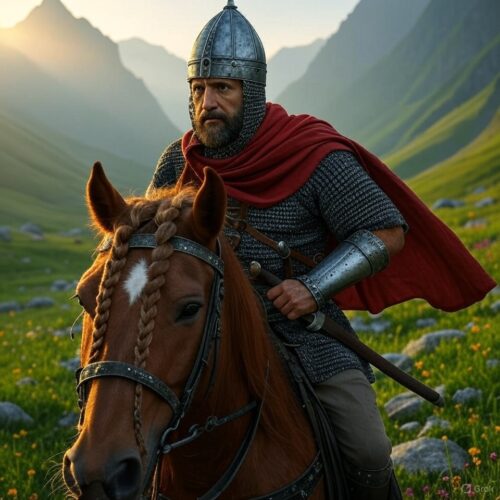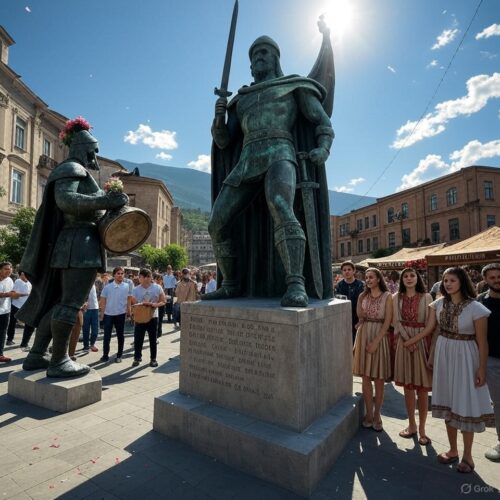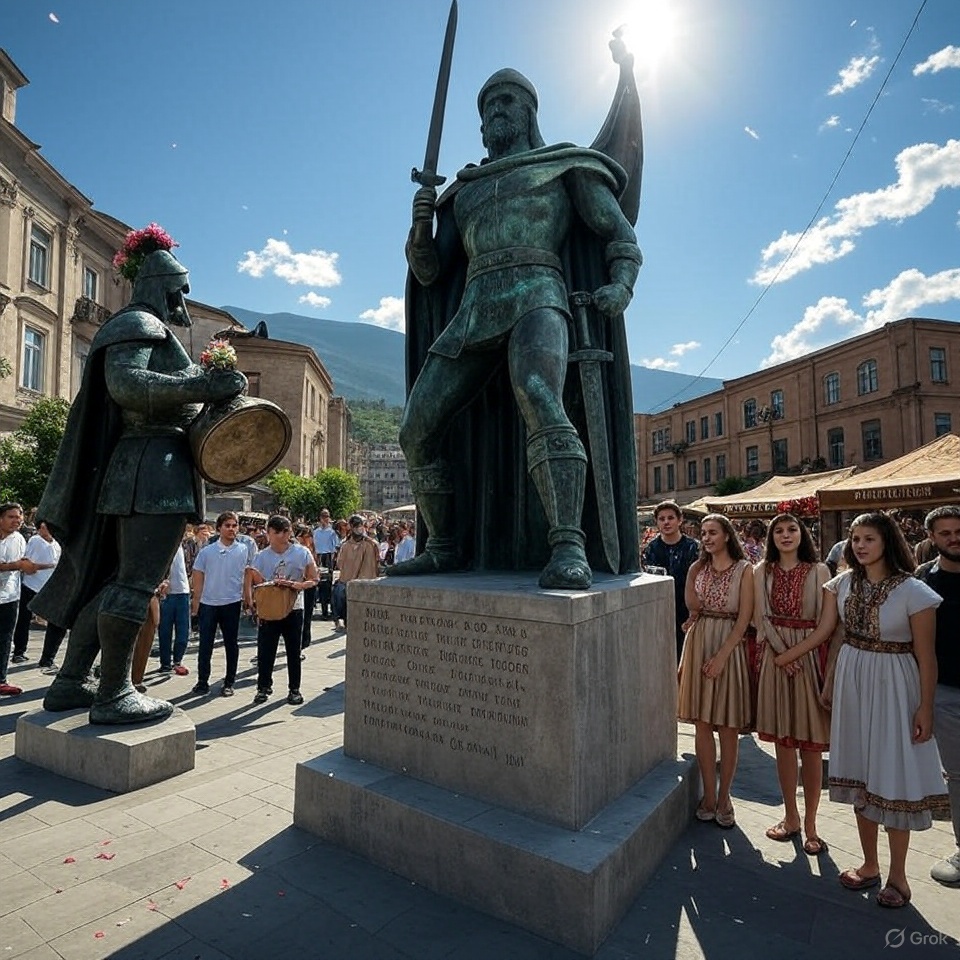Welcome to a deep dive into one of history’s most astonishing underdog stories—the Battle of Didgori. On August 12, 1121, in a dusty valley near what is now Tbilisi, Georgia, a small kingdom faced off against a massive empire in a clash that would redefine the map of the Caucasus and beyond. This wasn’t just a battle; it was a symphony of strategy, courage, and sheer audacity that turned the tide for an entire nation. We’ll explore the rich tapestry of events leading up to it, the nail-biting action on the field, and the ripples that echoed through centuries. And then, we’ll bridge that ancient valor to your everyday life, showing how the lessons from Didgori can spark personal triumphs today. Buckle up—this is going to be an epic, fun ride through time, packed with drama, heroes, and a dash of medieval flair.
Let’s set the stage with the world of the 12th century. The Seljuk Empire, a Turkic powerhouse that had swept through the Middle East like a sandstorm, was at its zenith. Originating from Central Asia, the Seljuks had converted to Islam and built an empire stretching from Anatolia to Persia, conquering Baghdad in 1055 and defeating the Byzantine Empire at the Battle of Manzikert in 1071. This victory opened the floodgates for Turkic migrations into Anatolia, shifting the region’s demographics forever. The Seljuks were masters of mobile warfare, relying on horse archers who could rain arrows while galloping at full speed, a tactic that had humbled many foes.
In the Caucasus, the Kingdom of Georgia was a Christian outpost in a sea of turmoil. Georgia, with its rugged mountains and fertile valleys, had been fragmented for centuries, battered by Arab, Byzantine, and now Seljuk invasions. By the early 11th century, Seljuk raids had devastated Georgian lands, enslaving populations and extracting heavy tributes. Tbilisi, the jewel of the region, had been under Muslim control since the 8th century Arab conquests, serving as an emirate that paid homage to various overlords, including the Seljuks.
Enter King David IV, known as David the Builder—a name that sounds like it belongs to a superhero, and in many ways, it did. Born in 1073, David ascended the throne at 16 in 1089 amid chaos. Georgia was a vassal to the Seljuks, paying annual tributes of gold, slaves, and soldiers. David, however, had other plans. Inspired by the Crusades raging in the Holy Land—where European knights were battling Muslim forces—he saw an opportunity to rally his people. He began reforming the army, centralizing power, and forging alliances. One key move was inviting the Kipchaks, nomadic Turkic warriors from the steppes north of the Caucasus, who were fleeing conflicts with the Cumans and Rus’. David married a Kipchak princess, integrated 40,000 of their warriors into his realm, and settled them in border regions, bolstering his forces with their expert horsemanship.
David’s reforms were thorough and innovative. He created the “mona-spa,” an elite royal guard of 5,000 heavily armored cavalrymen, trained in both Eastern and Western tactics. He suppressed rebellious nobles, unified the church under his banner, and promoted education and culture. By 1110, he stopped paying tribute to the Seljuks and launched offensives, recapturing key fortresses like Samshvilde and Rustavi. His victories at Ertsukhi in 1110 and Rakhsi in 1115 weakened Seljuk hold on the region.
The Seljuks couldn’t ignore this upstart king. In 1120, Muslim merchants from Tbilisi, Ganja, and Dmanisi complained to Sultan Mahmud II in Baghdad about Georgian raids disrupting trade. Mahmud, busy with internal strife, delegated the task to Ilghazi ibn Artuq, the Artuqid emir of Mardin. Ilghazi was no slouch—he had crushed the Crusaders at the Battle of Ager Sanguinis (the “Field of Blood”) in 1119, earning a reputation as a fierce jihad warrior. Ilghazi assembled a massive coalition: Seljuk Turks, Arabs from Damascus and Aleppo, Kurds, Bedouins, and even troops from the Emirate of Arran. Estimates of their size vary wildly—Georgian chronicles claim 600,000, Arab sources say 30,000, but modern historians peg it at 100,000 to 250,000. This was a multinational force, united by faith and the promise of loot, equipped with composite bows, scimitars, and light cavalry for hit-and-run tactics.
David’s army, by contrast, numbered about 55,600—40,000 Georgians, 15,000 Kipchaks, 500 Alans (Iranian nomads), and 200 Frankish Crusaders who had wandered east after the First Crusade. These Crusaders brought Western heavy knight tactics, adding a unique flavor to the Georgian ranks. David’s force was diverse but cohesive, trained in mountainous terrain that favored ambushes and close combat.
The campaign began in July 1121. Ilghazi’s army marched through Ganja, crossed the Kura River, and aimed for Tbilisi via the Trialeti route. David, informed by scouts, moved swiftly from his base at Mtskheta. On August 11, he divided his army: the main force under his command and a reserve under his son, Prince Demetrius (future Demetrius I). They camped near Didgori Mountain, a strategic spot with woods and hills that could conceal movements.
August 12 dawned with tension. Ilghazi, confident in his numbers, set up camp in the Didgori Valley, sending vanguard archers to probe. David sprang his trap. He sent a detachment of 200 Kipchaks to feign desertion, approaching the Seljuk camp with tales of discontent in the Georgian army. As Ilghazi and his commanders met them in their tent, the Kipchaks struck, killing several leaders and wounding Ilghazi himself. Chaos ensued—the Seljuk command was decapitated.
Seizing the moment, David launched a full assault. The Crusader knights charged first, smashing into the Seljuk vanguard with lances and swords, disrupting their arrow volleys. Georgian heavy cavalry followed, thundering down the slopes in a pincer movement: David on the right flank, Demetrius on the left from hiding. The terrain amplified the charge, turning it into a devastating wave. The Seljuks, leaderless and surprised, couldn’t form their usual mobile formations. Close-quarters fighting negated their archery advantage, and panic spread as rumors of Ilghazi’s death circulated.
The battle lasted just three hours. The Seljuk army shattered, fleeing in disarray. Georgians pursued for three days, slaughtering thousands and capturing vast spoils: tents, treasures, weapons, and even the Seljuk standards. Casualties were lopsided—Muslim losses estimated at 70-90% (tens of thousands dead, thousands captured), while Georgian dead were minimal, thanks to surprise and discipline.
The aftermath was transformative. With the Seljuk threat broken, David besieged Tbilisi, capturing it in 1122 after a nine-month siege. He moved the capital there from Kutaisi, declaring tolerance for Muslims while promoting Christianity. This victory sparked Georgia’s Golden Age, a period of expansion, cultural flourishing, and prosperity under David and his successors like Queen Tamar. Georgia reconquered lost territories, influenced the Crusades by diverting Seljuk attention, and became a regional power until the Mongol invasions in the 13th century.
But let’s zoom in on the fun, human elements. Imagine the Kipchak “deserters” – these steppe warriors, with their braided hair and fur-trimmed armor, riding into the enemy camp with straight faces, only to pull out daggers mid-conversation. It’s like a scene from a heist movie! Or the Frankish Crusaders, far from home, charging alongside Eastern allies— a true cross-cultural bromance. David himself was a poet and scholar, writing hymns and treatises; he wasn’t just a warrior but a Renaissance man before the Renaissance.
Historian Ivane Javakhishvili called Didgori “the most outstanding military performance in the entire history of Georgia.” It’s commemorated annually as Didgoroba, with festivals, reenactments, and feasts. The battle inspired literature, like Shota Rustaveli’s epic “The Knight in the Panther’s Skin,” symbolizing chivalry and unity.
Now, diving deeper into the military nuts and bolts. The Georgian army’s composition was a masterclass in hybridization. The mona-spa, armored in chainmail and lamellar plates, wielded lances, swords, and maces, blending Byzantine cataphract styles with local traditions. Kipchaks added mobility with composite bows, perfect for skirmishing. The Crusaders introduced the couched lance charge, a technique where knights tucked lances under arms for maximum impact—a game-changer against lighter foes.
Seljuk tactics, influenced by steppe warfare, emphasized feigned retreats and arrow showers. At Didgori, the valley’s confines limited this, turning the battle into a melee where Georgian heavy troops excelled. David’s intelligence network was key; scouts on fast ponies relayed enemy movements, allowing precise timing.
The coalition’s diversity was its Achilles’ heel. Ilghazi’s force included rival emirs with their own agendas—Dubays ibn Sadaqa from Hilla, Tughril from Arran—leading to poor coordination. When Ilghazi was wounded (he survived but died soon after from complications), the chain of command collapsed.
Post-battle, David’s mercy stood out. He ransomed captives humanely, contrasting Seljuk slave-raiding. This policy won loyalty from conquered peoples, aiding integration. Economically, spoils funded infrastructure: churches, roads, academies. Gelati Monastery, founded by David, became a center of learning, preserving ancient texts.
Expanding on the broader context, Didgori was part of the “Great Turkish Wars” era, where Seljuk expansion clashed with resurgent Christian states. It paralleled the Crusades—the First Crusade captured Jerusalem in 1099, and David’s alliances with Crusaders (some stayed in Georgia) created indirect links. Pope Calixtus II praised David as a defender of Christendom.
Lesser-known tidbits: The battle site, now a memorial with swords embedded in the ground, attracts hikers. Legends say David’s prayers summoned divine aid, hence “miraculous victory.” Archaeological finds, like arrowheads and armor fragments, confirm the scale.
Shifting gears to the Seljuk side, Ilghazi was a colorful figure. A former slave soldier, he rose through Artuqid ranks, marrying into power. His 1119 victory over Roger of Antioch made him a hero, but alcohol abuse (despite Islamic prohibitions) weakened him. At Didgori, his overconfidence—camping without proper scouts—proved fatal.
David’s legacy endures. He died in 1125, canonized by the Georgian Orthodox Church. His reforms laid foundations for a unified state, influencing modern Georgia’s identity amid Russian and Ottoman pressures.

The Golden Age saw architectural marvels like Svetitskhoveli Cathedral, literature, and trade booms. Georgia controlled key Silk Road routes, fostering multiculturalism—Tbilisi had mosques, synagogues, and churches coexisting.
But what about the Kipchaks’ role? These 15,000 warriors, resettled with land grants, assimilated, their descendants shaping Georgian nobility. Alans added Ossetian flavors to culture.
Casualty debates highlight medieval exaggeration. Georgian chronicler claims 400,000 enemy dead; realistic figures suggest 50,000-100,000 total Muslim force, with 30,000-60,000 lost. Georgian losses: perhaps 5,000, given the rout.
The pursuit was brutal—fleeing Seljuks drowned in rivers, died of thirst. Captured emirs were treated as guests, some converting.
Didgori’s significance extends to geopolitics. It delayed Seljuk recovery, aiding Byzantines and Crusaders. Saladin’s later rise might have been different without this setback.
Fun fact: Didgori inspired modern art, like films and songs. In 2021, Georgia celebrated the 900th anniversary with parades.

Now, let’s explore the valley itself. Didgori, meaning “great hill” in Georgian, features rolling terrain ideal for ambushes. Summer heat added misery to the Seljuks, encumbered by supplies.
David’s son Demetrius played a crucial role, his flank attack sealing the victory. He later became king, continuing expansions.
The battle’s speed—three hours—rivals ancient blitzes like Cannae. It’s studied in military academies for asymmetric warfare.
Transitioning to motivation, the Battle of Didgori teaches timeless lessons. A small force triumphed through preparation, innovation, and unity. Today, you can apply this to personal challenges, turning underdog status into victory.

How does this benefit you? By embracing Didgori’s spirit, you build resilience and strategy in daily life.
– **Cultivate Strategic Planning**: Like David’s reforms, assess your goals. Identify weaknesses (e.g., skill gaps) and build strengths (e.g., learn new tools). Benefit: Achieve career advancements by anticipating obstacles.
– **Forge Alliances**: David allied with Kipchaks and Crusaders. Network with diverse people—join clubs, mentor others. Benefit: Gain support during tough times, like job loss, through a strong circle.
– **Embrace Surprise Tactics**: The Kipchak ruse shows creativity wins. In negotiations, use unexpected approaches, like unique pitches in interviews. Benefit: Stand out, securing promotions or deals.
– **Maintain Discipline and Unity**: Georgian cohesion beat coalition disarray. Align personal habits—daily routines for health, finances. Benefit: Improve well-being, reducing stress and boosting productivity.
– **Pursue Lifelong Learning**: David’s scholarly side. Read books, take courses on history or skills. Benefit: Adapt to changes, like tech shifts, staying relevant.

A plan to apply this:
- **Week 1: Reflect and Plan** – Journal your “battles” (goals). Research strategies, like David’s reforms.
- **Week 2: Build Alliances** – Connect with 3 new people via events or online.
- **Week 3: Innovate** – Try a new tactic in a challenge, e.g., creative problem-solving at work.
- **Week 4: Execute and Pursue** – Act on your plan, track progress, celebrate wins like Didgori feasts.
- **Ongoing: Learn and Adapt** – Read one history book monthly, apply lessons.
This approach turns history into a motivational toolkit, making you unstoppable.


